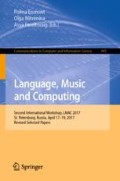Abstract
The four main modules of the classic model for the faculty of language postulated in generative linguistics—lexicon, syntax, phonology/prosody and semantics—have been hypothesized to each have a (more or less abstract) equivalent module in the faculty of music. This hypothesis suggests that it should be possible to explain the way these modules interact—represented by the inverted-Y form of the model—in a similar fashion. I propose a refinement of Katz and Pesetsky’s (2011) hypothesis by suggesting that there are a number of common properties shared by the lexical systems of music and language, and it is precisely this that explains some of their fundamental syntactic similarities. What makes the two systems different is not primitively the properties of their lexical modules, but rather the radically different nature of their respective interpretive modules—semantics in the case of language (or, technically, the conceptual-intentional system), and the Tonal-Harmonic Component (THC) in the case of music.
Access this chapter
Tax calculation will be finalised at checkout
Purchases are for personal use only
References
Adger, D.: Core Syntax. Oxford University Press, Oxford (2003)
Arbib, M.A. (ed.): Language, Music, and the Brain. A Mysterious Relationship. MIT Press, Cambridge (2013)
Bernstein, L.: The Unanswered Question. Six talks at Harvard. Harvard University Press, Cambridge (1976)
Chomsky, N.: The Minimalist Program. MIT Press, Cambridge (1995)
Fitch, W.T.: The biology and evolution of music: a comparative perspective. Cognition 100, 173–215 (2006)
Fodor, J.A.: The Modularity of Mind. MIT Press, Cambridge (1983)
Giblin, I.: Music and the Generative Enterprise. University of New South Wales, Sydney (2008)
Grodzinsky, Y.: Neural substrates for linguistic and musical abilities: a neurolinguist’s perspective. In: Toivonen, I., Csúri, P., Van der Zee, E. (eds.) Structures in the Mind: Essays on Language, Music, and Cognition in Honor of Ray Jackendoff, pp. 325–346. MIT Press, Cambridge (2015)
Hamanaka, M., Hirata, K., Tojo, S.: Implementing methods for analysing music based on Lerdahl and Jackendoff’s Generative theory of tonal music. In: Meredith, D. (ed.) Computational Music Analysis, pp. 221–249. Springer, Heidelberg (2016). https://doi.org/10.1007/978-3-319-25931-4_9
Jackendoff, R.: Parallels and nonparallels between language and music. Music Percept. 26(3), 195–204 (2009)
Jackendoff, R., Lerdahl, F.: The capacity for music: what is it, and what’s special about it? Cognition 100, 33–72 (2006)
Katz, J.: Exceptional cadential chords and the nature of tonic-marking. In: Halpert, C., Kotek, H., van Urk, C. (eds.) A Pesky Set: A festschrift for David Pesetsky, pp. 447–456. MIT Working Papers in Linguistics, Cambridge (2017)
Katz, J., Pesetsky, D.: The Identity Thesis for Language and Music (2011). http://www.sfu.ca/~hedberg/katzEtAl_11_The-Identity-.3.pdf
Lerdahl, F.: Tonal Pitch Space. Oxford University Press, Oxford (2001). https://doi.org/10.1093/acprof:oso/9780195178296.001.0001
Lerdahl, F., Jackendoff, R.: A Generative Theory of Tonal Music. MIT Press, Cambridge (1983)
Lerdahl, F., Krumhansl, C.L.: Modeling tonal tension. Music Percept. 24(4), 329–366 (2007). https://doi.org/10.1525/mp.2007.24.4.329
McMullen, E., Saffran, J.R.: Music and language: a developmental comparison. Music Percept. 21(3), 289–311 (2004)
Patel, A.D.: Music, Language, and the Brain. Oxford University Press, Oxford (2008)
Peretz, I.: The nature of music from a biological perspective. Cognition 100(1), 1–32 (2006). https://doi.org/10.1016/j.cognition.2005.11.004
Rebuschat, P., Rohrmeier, M., Hawkins, J.A., Cross, I. (eds.): Language and Music as Cognitive Systems. Oxford University Press, Oxford (2012)
Rohrmeier, M.: A generative grammar approach to diatonic harmonic structure. In: Sound and Music Computing Conference, Lefkada, Greece, pp. 97–100 (2007)
Rohrmeier, M.: Towards a generative syntax of tonal harmony. J. Math. Music 5(1), 35–53 (2011)
Acknowledgements
This research has been financed by a public grant from the Ministerio de Educación, Cultura y Deportes of the Spanish government (FPU14/04707) and forms part of subproject FFI2014-56968-C4-1-P, financed by the Ministerio de Economía y Competitividad, and project 2017SGR-634, financed by AGAUR-Generalitat de Catalunya.
Author information
Authors and Affiliations
Corresponding author
Editor information
Editors and Affiliations
Rights and permissions
Copyright information
© 2019 Springer Nature Switzerland AG
About this paper
Cite this paper
Quintana, O. (2019). Does the Y-Model for Language Work for Music?. In: Eismont, P., Mitrenina, O., Pereltsvaig, A. (eds) Language, Music and Computing. LMAC 2017. Communications in Computer and Information Science, vol 943. Springer, Cham. https://doi.org/10.1007/978-3-030-05594-3_1
Download citation
DOI: https://doi.org/10.1007/978-3-030-05594-3_1
Published:
Publisher Name: Springer, Cham
Print ISBN: 978-3-030-05593-6
Online ISBN: 978-3-030-05594-3
eBook Packages: Computer ScienceComputer Science (R0)

